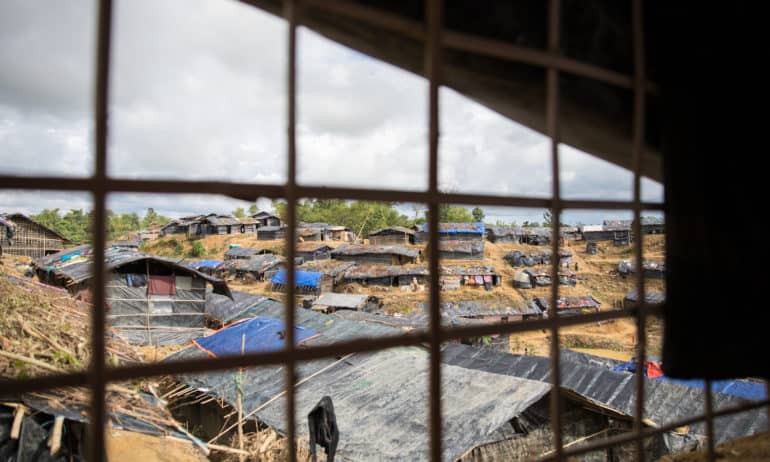Food security in Bangladesh is among major concerns as the 2018 monsoon season continues, according to United Nations humanitarian aid organizations. This region, prone to flooding and food shortage, experiences an additional stress this year as it copes with hundreds of thousands of Rohingya refugees who have crossed the border from Myanmar’s Rakhine province into Bangladesh since 2017. Ninety-one percent of the refugee population here relies only on food from humanitarian organizations, and rates of food insecurity and malnutrition meet or exceed emergency levels.
The Rakhine province is in northern Myanmar on the Bay of Bengal and borders the southern tip of Bangladesh. The country has experienced rising seas, deforestation, and increasing rainfall in recent years, with an approximate 60-millimeter increase in monthly average rainfall from 2012 to 2015.
The monsoon season can last for seven to eight months, peaking in July and August. The heavy rains traditionally devastate farmland and flood a significant percentage of inhabited land. In 2017, monsoon flooding covered nearly two-thirds of the country and affected an estimated eight million Bangladeshis. Climate shocks during 2017’s wet season, like flash-flooding, damaged hundreds of square miles of crops across the country, taking a dramatic toll on farmers.
Reporting from the Inter Sector Coordination Group (ISCG), which is organizing the humanitarian aid effort for Rohingya refugees, estimated the refugee count in Bangladesh to have reached nearly 900,000 in April 2018. According to the most recent report, more than 600,000 refugees are living in Kutupalong-Balukhali camp, southeast of the town of Cox’s Bazar. Other smaller camps of tens of thousands of refugees are scattered throughout the Cox’s Bazar region.
The swell in the refugee population is a result of Myanmar’s unwillingness to accept Rohingya Muslims as citizens, said U.N. High Commissioner for Human Rights Zeid Ra‘ad al-Hussein in a speech to the Human Rights Council in September 2017. The conflict goes back decades, however: the Myanmar government began stripping the Rohingya of rights in the early 1960s, including rights to citizenship, and even excluded them from the 2014 census.
Since August 2017, intensifying violence by government military forces has driven Rohingya Muslims north to Bangladesh in what has been labeled since fall 2017 as “the world’s fastest growing refugee crisis” by the U.N. Office of Coordination of Humanitarian Affairs (OCHA). According to Commissioner al-Hussein, what’s happening in the Rakhine province “seems like a textbook example of ethnic cleansing.”
OCHA reports that “the concentration of refugees in Cox’s Bazar is now amongst the densest in the world” due to the rapid influx, which has doubled the region’s population and stressed the local infrastructure. Refugees are living in cramped and unsteady shelters unsuitable for heavy rains and winds. Sudden increase in fuel demand has led to massive deforestation, which the U.N. Food and Agriculture Organization (FAO) says can increase the already heightened risk of landslides. The Strategic Executive Group, a joint advisory group of officials from the United Nations and the International Organization for Migration (IOM), has estimated that upwards of 200,000 Rohingya refugees are living in regions that will flood or collapse this the rainy season.
Davide Rossi heads the coordinated response by FAO and the U.N. World Food Programme (WFP). Rossi said that a quick response during the monsoon season is critical for saving lives, including fortified biscuits and cooked meals, especially while risk of flooding and landslides is high.
Since the fall of 2017, humanitarian organizations and governments have partnered to provide emergency food rations and stores of food staples, strategically locating them throughout the camps for ease of access in emergency weather situations. Even without major climate shocks, achieving food security is challenging in Bangladesh, which ranked least food secure among its south Asian neighbors late in 2017.
In recent evaluations, thirty-three percent of refugees have scored poorly on food intake and food quality measures and rates of acute malnutrition among adults exceed emergency rates: 24 percent in the Kutupalong camp and nearly 20 percent in makeshift refugee settlements.
Additionally, a report from the U.S. Agency for International Development (USAID) found an estimated 69,000 Rohingya children under five years old experiencing severe acute malnutrition, which can have lasting health effects, including increased vulnerability to disease in the short term.
FAO Emergency Coordinator Peter Agnew reports, “seeing food prices going up and daily wages going down from US$6 to US$2, and an intense competition for firewood and food.” He advocates that support for the host community, a population itself vulnerable to food insecurity and climate shocks, is crucial, saying “host community members tell us that this situation is creating great strains on their families.”
Coordinated response by the humanitarian sector is ongoing in Cox’s Bazar. According to Rossi, further resilience building and infrastructure improvements, such as agricultural livelihood-building, farmer training, home gardening promotion, and farm-to-market model business support, will be critical to the region’s long-term stability.











